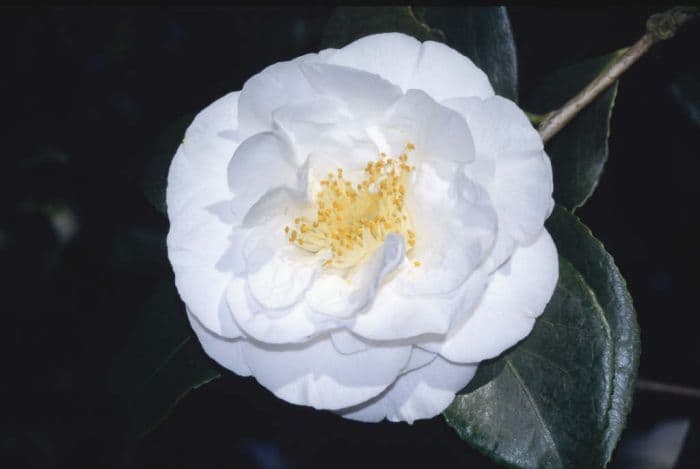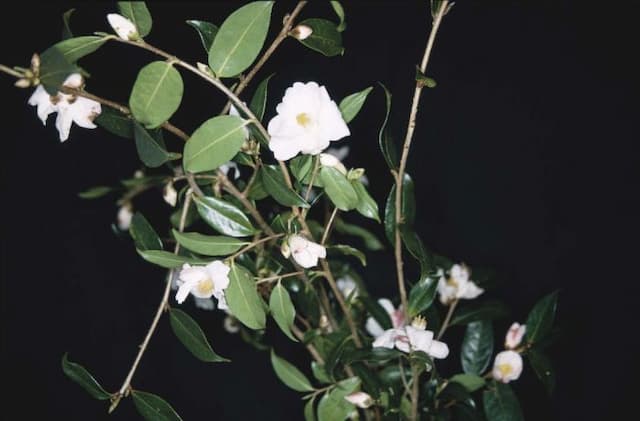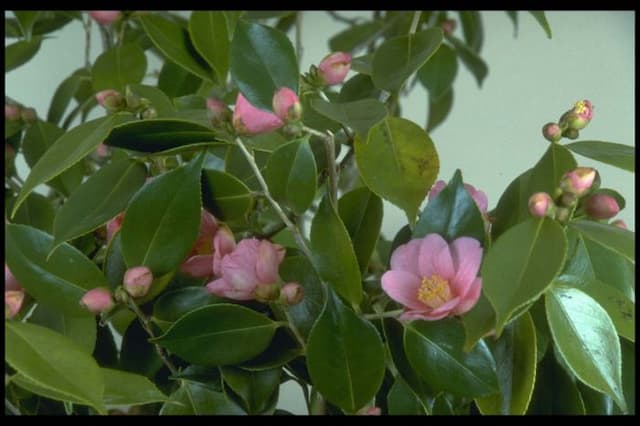Japanese Camellia Camellia japonica 'Hakurakuten'

ABOUT
Camellia japonica 'Hakurakuten', commonly known as the Japanese camellia, is an ornamental plant known for its striking flowers and glossy, dark green foliage. The leaves are typically oval-shaped with a leathery texture and may have a slightly serrated edge. The standout feature of 'Hakurakuten' is its blooms; this cultivar produces large, exquisitely formed double flowers. The petals are usually white or may have a hint of pink, often appearing waxy or porcelain-like in texture. These blossoms frequently display a ruffled or peony-like form and can create a striking contrast against the lush, green leaves. The overall impression is one of elegance and refined beauty, characteristic of many Japanese camellia cultivars.
About this plant
 Names
NamesFamily
Theaceae
Synonyms
Japanese Camellia, Rose of Winter, Tsubaki
Common names
There are no scientific synonyms for Camellia japonica 'Hakurakuten'; the basic scientific name is Camellia japonica 'Hakurakuten'.
 Toxicity
ToxicityTo humans
The Japanese camellia, specifically the cultivar 'Hakurakuten', is not known to be toxic to humans. In general, the Japanese camellia is considered non-poisonous, and there are no commonly reported symptoms of poisoning from ingesting parts of this plant. However, as with any plant material, individual allergies and sensitivities could cause adverse reactions in some people.
To pets
The Japanese camellia, including the 'Hakurakuten' cultivar, is also not considered toxic to pets such as dogs and cats. It is generally regarded as safe when pets come into contact with the plant. There are no widely known symptoms of poisoning in pets from ingesting parts of this plant, but as with humans, individual sensitivities could potentially lead to mild stomach upset or other allergic reactions in some animals.
 Characteristics
CharacteristicsLife cycle
Perennials
Foliage type
Evergreen
Color of leaves
Green
Flower color
White
Height
6-10 feet (1.8-3 meters)
Spread
5-7 feet (1.5-2.1 meters)
Plant type
Shrub
Hardiness zones
7
Native area
Japan
Benefits
 General Benefits
General Benefits- Aesthetic Appeal: Camellia japonica 'Hakurakuten', commonly known as the Japanese camellia, produces beautiful, showy flowers that enhance the visual appeal of gardens and landscapes.
- Year-Round Interest: With glossy evergreen leaves and a long flowering period, it provides interest in the garden throughout the year.
- Habitat Support: It offers habitat and food for various insects, including bees that are attracted to its flowers for pollen and nectar.
- Versatility in Landscaping: Japanese camellia can be used in various landscape designs, including formal gardens, woodland settings, and as specimen plants.
- Durability: It is known for being relatively pest and disease resistant, making it a durable choice for many gardeners.
- Privacy Screening: The dense foliage of the camellia can be used for privacy hedges or screens in residential landscapes.
- Erosion Control: The plant's root system can help stabilize the soil and prevent erosion, especially in shaded slopes.
 Medical Properties
Medical PropertiesThis plant is not used for medical purposes.
 Air-purifying Qualities
Air-purifying QualitiesThis plant is not specifically known for air purifying qualities.
 Other Uses
Other Uses- Ink for Stamping: The petals of Camellia japonica can be crushed and mixed with water to create a natural red ink that can be used for stamping or traditional calligraphy purposes.
- Macro Photography: Camellia japonica's intricate flowers are often used as subjects in macro photography, to capture their detailed beauty and unique patterns.
- Natural Dye: The vibrant petals can be boiled to create a natural dye for fabric, yielding subtle shades of pink or red depending on the concentration and the type of material.
- Botanical Illustration: Artists and botanists utilize Camellia japonica as a model for botanical illustration, capturing its form and color in detailed artworks.
- Companion Planting: When planted in a garden, Camellia japonica can provide visual interest and contrast, helping to highlight other plants in landscape design.
- Feng Shui: In some Asian cultures, it’s believed Camellia japonica brings positive energy when planted in the right place according to Feng Shui principles.
- Educational Tool: Camellia japonica can be used in schools and educational programs to teach about plant biology, life cycles, and the importance of flower pollination.
- Culinary Garnish: The non-toxic petals of the Camellia japonica can be used as an elegant garnish for culinary dishes, adding a touch of color and sophistication.
- Natural Confetti: Dried petals of Camellia japonica can serve as biodegradable confetti for celebrations, offering an environmentally friendly alternative to synthetic confetti.
- Culture and Symbolism: The flower is deeply rooted in many cultures as a symbol of love, affection, and admiration, and is used in various cultural ceremonies.
Interesting Facts
 Feng Shui
Feng ShuiThe Camellia is often used in Feng Shui to attract positive energy, create a serene atmosphere, and enhance the beauty of a space. It can be placed in the wealth corner of a garden or home, which is typically the southeast, to foster prosperity and abundance, or used as a love cure in the southwest to invite romance and passionate energy.
 Zodiac Sign Compitability
Zodiac Sign CompitabilityThe Camellia is not used in astrology practice.
 Plant Symbolism
Plant Symbolism- Adoration: Camellia japonica 'Hakurakuten' is most commonly known simply as Camellia, which often symbolizes deep adoration or admiration for someone.
- Perfection: With its perfect, delicate petals, the Camellia represents the pursuit of perfection in many cultures.
- Longevity: Owing to the longevity of the plant’s life span, Camellias are often associated with enduring or eternal life.
- Affection: Their lush, full blooms can signify the boundless and unreserved affection one person holds for another.
- Divine: In certain cultures, the beauty and almost geometric perfection of the Camellia can be seen as symbolic of divine beauty.
 Water
WaterThe Japanese Camellia, known as Camellia japonica 'Hakurakuten', prefers consistent moisture but does not tolerate standing water, so well-draining soil is essential. Water this plant deeply and thoroughly once a week, allowing the top inch of soil to dry out between waterings, which promotes strong root development. Each watering session should involve applying approximately one to one and a half gallons of water directly to the base of the plant to avoid wetting the foliage. During the summer or in particularly dry conditions, you may need to water twice a week, while in cooler months, water less frequently as the plant's water requirements decrease.
 Light
LightThe Japanese Camellia thrives in partial shade where it can receive dappled sunlight, making a spot with morning sun and afternoon shade ideal for this plant. Direct, harsh sunlight can burn the leaves and damage the flowers, so it is best to avoid south-facing exposures that tend to get too bright and hot. Ensure it gets enough light to promote healthy growth without the adverse effects of intense sun exposure.
 Temperature
TemperatureThe Japanese Camellia flourishes in temperatures between 60 and 75 degrees Fahrenheit but can tolerate short periods outside this range. Ensure it's sheltered from extreme cold, as temperatures below 20 degrees Fahrenheit can cause damage. They prefer an environment that is not prone to dramatic temperature fluctuations, especially in spring during flowering.
 Pruning
PruningPrune the Japanese Camellia soon after flowering, which typically ends in spring, to maintain its shape and promote the growth of next year's buds. It's important not to prune too late in the season as you may inadvertently remove these buds. Light pruning is usually sufficient, focusing on removing dead or weak branches to enhance air circulation and the overall health of the plant.
 Cleaning
CleaningAs needed
 Soil
SoilThe Japanese Camellia 'Hakurakuten' prefers well-draining, humus-rich soil with an acidic pH between 5.5 to 6.5. A mix of peat, pine bark, and perlite is ideal to provide aeration and proper drainage.
 Repotting
RepottingJapanese Camellias like 'Hakurakuten' should be repotted every 2-3 years to prevent root-binding and replenish nutrients in the soil.
 Humidity & Misting
Humidity & MistingJapanese Camellia 'Hakurakuten' thrives best at a high humidity level of about 50-80%, which mimics its natural humid environment.
 Suitable locations
Suitable locationsIndoor
Provide bright, indirect light and keep humus-rich.
Outdoor
Plant in dappled shade with acidic, well-drained soil.
Hardiness zone
7-9 USDA
 Life cycle
Life cycleCamellia japonica 'Hakurakuten', commonly known as the Japanese Camellia, begins its life cycle as a seed, which after stratification germinates in spring. The seedling stage is marked by the development of the first true leaves, and the plant gradually matures over several years, developing a sturdy stem and a root system. Upon reaching maturity, the Japanese Camellia begins its reproductive phase, typically producing ornate white flowers with pink blush that attract insect pollinators. After pollination, the flowers give way to seed pods that mature over several months before releasing their seeds to start a new cycle. The plant then enters a period of vegetative growth and dormancy, influenced by the seasons, with active growth in spring and summer and dormancy in fall and winter. The Japanese Camellia is a perennial shrub, with a life span that can extend over multiple decades if provided with suitable growing conditions.
 Propogation
PropogationPropogation time
Spring to early summer
Camellia japonica 'Hakurakuten', commonly known as the Japanese camellia, is most successfully propagated through semi-hardwood cuttings. This method involves taking a cutting from new growth that has begun to mature and harden; this typically occurs in late summer or early fall. Cut a 4 to 6 inch (10 to 15 cm) segment just below a leaf node, ensuring at least two sets of leaves remain on the cutting. Remove the bottom set of leaves and dip the cut end in rooting hormone to encourage root development. Plant the cutting in a pot filled with a mixture of peat and perlite or sand, ensuring the removed leaf nodes are buried. Cover the pot with a plastic bag or place it in a propagator to maintain high humidity. Roots generally develop within 6 to 8 weeks, after which the new plant can be transplanted to a more permanent location.









